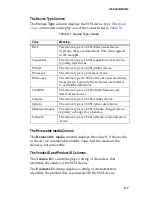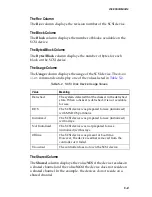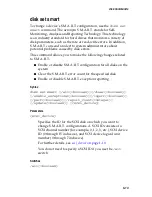
5-13
disk Commands
disk set smart
To change a device’s S.M.A.R.T. configuration, use the
disk set
smart
command. The acronym S.M.A.R.T. stands for Self-
Monitoring, Analysis and Reporting Technology. This technology
is an industry standard for hard drives that monitors a variety of
disk parameters, such as the rate of read-write errors. In addition,
S.M.A.R.T. can send an alert to system administrators about
potential problems caused by disk errors.
This command allows you to make the following changes related
to S.M.A.R.T.:
■
Enable or disable S.M.A.R.T. configuration for all disks on the
system
■
Clear the S.M.A.R.T. error count for the specified disk
■
Enable or disable S.M.A.R.T. exception reporting
Syntax
disk set smart [/all{=boolean}][/clear{=boolean}]
[/enable_exceptions{=boolean}][/logerr{=boolean}]
[/perf{=boolean}][/report_count{=integer}]
[/update{=boolean}] [{scsi_device}]
Parameters
{scsi_device}
Specifies the ID for the SCSI disk on which you want to
change S.M.A.R.T. configurations. A SCSI ID consists of a
SCSI channel number (for example, 0, 1, 2, 3, etc.), SCSI device
ID (0 through 15 inclusive), and SCSI device logical unit
number (0 through 7 inclusive).
For further details, see
scsi_device
on page 1-10
.
You do not need to specify a SCSI ID if you use the
/all
switch.
Switches
/all{=boolean}
Summary of Contents for AAR-2020SA
Page 1: ...R Command Line Interface Reference Guide...
Page 107: ...3 76 container Commands container extend file_system page 3 40 container list page 3 50...
Page 170: ...4 24 controller Commands Related Commands controller commands controller details page 4 2...
Page 220: ...7 4 logfile Commands Related Commands logfile commands logfile end page 7 2...
















































